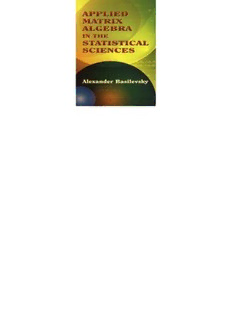
Applied Matrix Algebra in the Statistical Sciences PDF
Preview Applied Matrix Algebra in the Statistical Sciences
DOVER BOOKS ON MATHEMATICS AN INTRODUCTION TO LINEAR ALGEBRA AND TENSORS, M. A. Akivis and V. V. Goldberg. (0-486-63545-7) VECTORS, TENSORS AND THE BASIC EQUATIONS OF FLUID MECHANICS, Rutherford Aris. (0-486-66110-5) ASYMPTOTIC EXPANSIONS OF INTEGRALS, Norman Bleistein and Richard A. Handelsman. (0-486-65082-0) NON-EUCLIDEAN GEOMETRY, Roberto Bonola. (0-486-60027-0) INTRODUCTION TO PARTIAL DIFFERENTIAL EQUATIONS, Arne Broman. (0-486-66158-X) AN INTRODUCTION TO ORDINARY DIFFERENTIAL EQUATIONS, Earl A. Coddington. (0-486-65942-9) MATRICES AND LINEAR TRANSFORMATIONS, Charles G. Cullen. (0-486-66328-0) INTRODUCTION TO NONLINEAR DIFFERENTIAL AND INTEGRAL EQUATIONS, H. T. Davis. (0-486-60971-5) SOME THEORY OF SAMPLING, W. Edwards Deming. (0-486-64684-X) 2 INTRODUCTION TO LINEAR ALGEBRA AND DIFFERENTIAL EQUATIONS, John W. Dettman. (0-486-65191-6) LINEAR PROGRAMMING AND ECONOMIC ANALYSIS, Robert Dorfman, Paul A. Samuelson and Robert M. Solow. (0-486-65491-5) p THEORY OF H SPACES, Peter L. Duren. (0-486-41184-2) THE THIRTEEN BOOKS OF EUCLID’S ELEMENTS, translated with an introduction and commentary by Sir Thomas L. Heath. (0-486-60088-2, 0-486-60089-0, 0-486-60090-4) Three-volume set CALCULUS OF VARIATIONS WITH APPLICATIONS, George M. Ewing. (0-486-64856-7) DIFFERENTIAL FORMS WITH APPLICATIONS TO THE PHYSICAL SCIENCES, Harley Flanders. (0-486-66169-5) AN INTRODUCTION TO THE CALCULUS OF VARIATIONS, Charles Fox. (0-486-65499-0) FOUNDATIONS OF MODERN ANALYSIS, Avner Friedman. (0-486-64062-0) TECHNICAL CALCULUS WITH ANALYTIC GEOMETRY, Judith L. Gersting. (0-486-67343-X) INTRODUCTION TO DIFFERENCE EQUATIONS, Samuel Goldberg. (0-486-65084-7) PROBABILITY: An Introduction, Samuel Goldberg. (0-486-65252-1) DIFFERENTIAL GEOMETRY, Heinrich W. Guggenheimer. (0-486-63433-7) 3 NUMERICAL METHODS FOR SCIENTISTS AND ENGINEERS, Richard Hamming. (0-486-65241-6) PROBABILITY: Elements of the Mathematical Theory, C. R. Heathcote. (0-486-41149-4) ORDINARY DIFFERENTIAL EQUATIONS, E. L. Ince. (0-486-60349-0) LIE ALGEBRAS, Nathan Jacobson. (0-486-63832-4) GREEK MATHEMATICAL THOUGHT AND THE ORIGIN OF ALGEBRA, Jacob Klein. (0-486-27289-3) THEORY AND APPLICATION OF INFINITE SERIES, Konrad Knopp. (0-486-66165-2) APPLIED ANALYSIS, Cornelius Lanczos. (0-486-65656-X) 4 Applied Matrix Algebra in the Statistical Sciences Alexander Basilevsky 5 Copyright Copyright © 1983 by Alexander Basilevsky All Rights Reserved. Bibliographical Note This Dover edition, first published in 2005, is an unabridged republication of the work originally published by North-Holland, New York, in 1983. 9780486153377 Manufactured in the United States of America Dover Publications, Inc., 31 East 2nd Street, Mineola, N.Y 11501 6 To Florence and Roxan Basilevsky 7 Table of Contents DOVER BOOKS ON MATHEMATICS Title Page Copyright Page Dedication Preface Chapter 1 - Vectors Chapter 2 - Vector Spaces Chapter 3 - Matrices and Systems of Linear Equations Chapter 4 - Matrices of Special Type Chapter 5 - Latent Roots and Latent Vectors Chapter 6 - Generalized Matrix Inverses Chapter 7 - Nonnegative and Diagonally Dominant Matrices References Index 8 Preface In recent decades matrix algebra and statistics and probability have become two of the most important areas of theoretical and applied mathematics, in terms of university curricula as well as actual research in the social, geographical, human, and life sciences. With a growing awareness of the usefulness of matrices in the statistical sciences has come a very elegant development of statistical theory, combining the principles of probability and linear algebra. This has greatly increased our understanding of the algebraic linear structures and properties of statistical models. At the same time, however, many of the more specialized theorems of linear algebra, as well as particular types of matrices commonly used in statistics, are usually not discussed in the more theoretical linear algebra texts, whose main purpose is to give the student a broad perspective of linear algebraic structures rather than a more specialized view. Usually matrix results of interest to statisticians are scattered in the appendices and introductory chapters of advanced statistical publications or are discussed in journal articles not readily available to the student and researcher. This in turn tends to influence university programs in statistics to place less importance on matrix algebra than it deserves, with the result that students involved in statistics and other quantitative programs are often forced to rely on courses taught in pure mathematics in order to obtain even the most elementary notions of applied linear algebra. The present volume is therefore an attempt to collect into a single text some of the main results of matrix algebra that find wide 9 use in both applied and theoretical branches of the statistical sciences, and provide a bridge between linear algebra and statistical models. It is hoped that this volume will be useful to students undertaking undergraduate or postgraduate degrees in quantitative areas such as statistics, probability, econometrics, psychometrics, sociometrics, biometrics, the various life and earth sciences, as well as quantitative geography and demography, by providing a self-contained book on applied matrix algebra designed for statistical application. Also, it is the intention of the author to place at the disposal of the researcher a handy reference book to be consulted when the need arises. The material has therefore been organized in a self-contained manner, beginning with introductory concepts and leading to the more advanced topics such as latent roots and vectors, generalized inverses, and nonnegative matrices. At the end of each chapter is a section dealing with real-world statistical applications, as well as exercises, in order to provide the reader with concrete examples (and motivation) of how (and why) matrices are useful in the statistical sciences, as well as with an illustration of the matrix algebra. Whenever possible, proofs of the theorems have been structured in such a way so as to obviate the use of abstract algebraic notions. The only mathematical background that is needed is a good knowledge of high school mathematics, as well as a first course in statistics, although certain sections, such as those dealing with quadratic forms, require differential calculus. The author has also attempted to relate algebraic results to geometric concepts and diagrams in order to render the material more understandable from the intuitive point of view. The main purpose of this book, however, is to provide the reader with a systematic development of applied matrix theory, and the author has included more-or-less complete proofs of the theorems. 10
